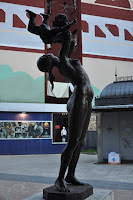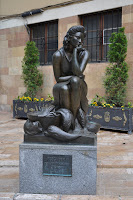(...)
Fearing night would soon fall and realising I wouldn't have enough time to visit everything I wanted to during this short one day and a half weekend I rushed towards Plaza de Trascorrales to photograph some more statues.
Plaza de Trascorrales is a beautiful square, whose name is connected to the fact that there were quite a few stables behind some of the coloured houses one can see arond it. Part of it is occupied by the former fish market now turned into a Cultural Centre and as a reminder of the important role it played in 1866 two statues have been made, which naturally catch the passerby's attention - "El Vendedor de pescado" by José Antonio Garcia Pietro Llonguera (1996) and "La Pescadera" by Sebastian Miranda.

"El vendedor de pescado"

"La pescadera"

"La Lechera" by Manuel Garcia Linares (1996) pays tribute to the many women who, coming from the outskirts of Oviedo riding on their mules, used to sell milk door to door in the seventies.

Walking towards Plaza de Paraguas we came across several "sidrerias" where cider was beyond no doubt the sellected drink. Cider is considered a way of life in Asturias and Asturians are known to drink it at all times. It must be poured from a height aerating it as it splashes into the glass and according to the local ettiquete improper to pour one own's cider.
I won't be able to say what it tastes like because despite being curious as to what sort of beverage it was I didn't dare sip a single drop.

Walking about we still came across the typical Oviedo sculpture and some more statues, one of which right in front of the University façade.

Campomanes by Amado Glez Hevia



"Mujer sentada" by Manuel Hugué (1930)
Before collecting Jonas' luggage to have it transfered to the new Hotel I had booked in the outskirts of Oviedo we sat down at a local restaurant and had a traditional Asturian dish "Fabada Asturiana", which is a rather rich stew made with large white beans, shoulder pork (lacon Gallego) bacon (tocino), "morcilla" and "chorizo".
We then walked down towards Pumarin where we came across Foncalada. Built during the reign of Alfonso III, the Great (866-910) it is a unique example of a civil construction intended for public use (once it protected a natural drinking water spring rising directly out of the ground) dating back from the High Middle Ages.
Its front bears a sculpture relief of the Victory Cross with Alpha and Omega hanging from its arms.

Just before reaching Hotel Confort I still managed to photograph a street painting and another statue which stood in a playground area close by in spite of beginning to get dark.


Though we might have taken a bus (nº 2) which regularly ran across the city we took a taxi instead and soon went to sleep in the quiet area of Corredoria (Northeast of the city) where Hotel Angel was located.




















No comments:
Post a Comment